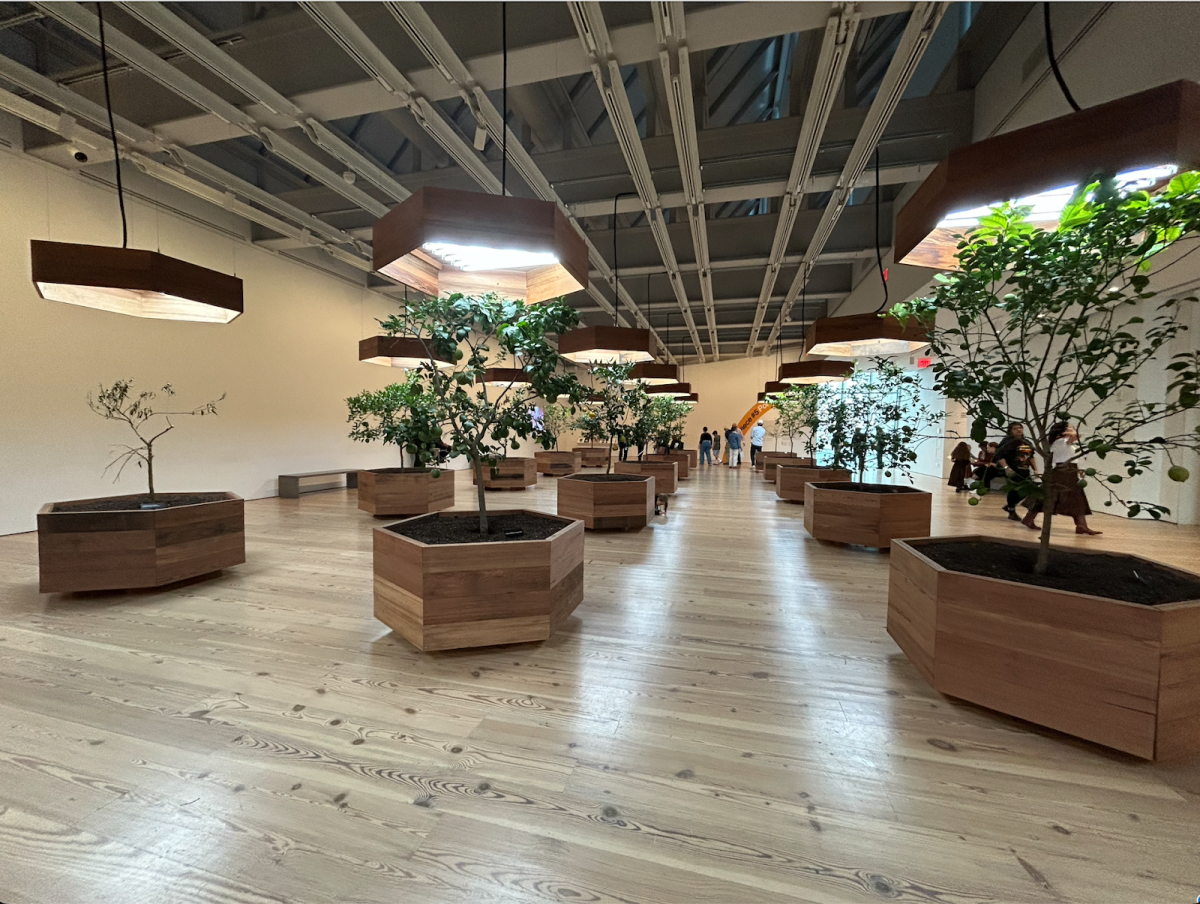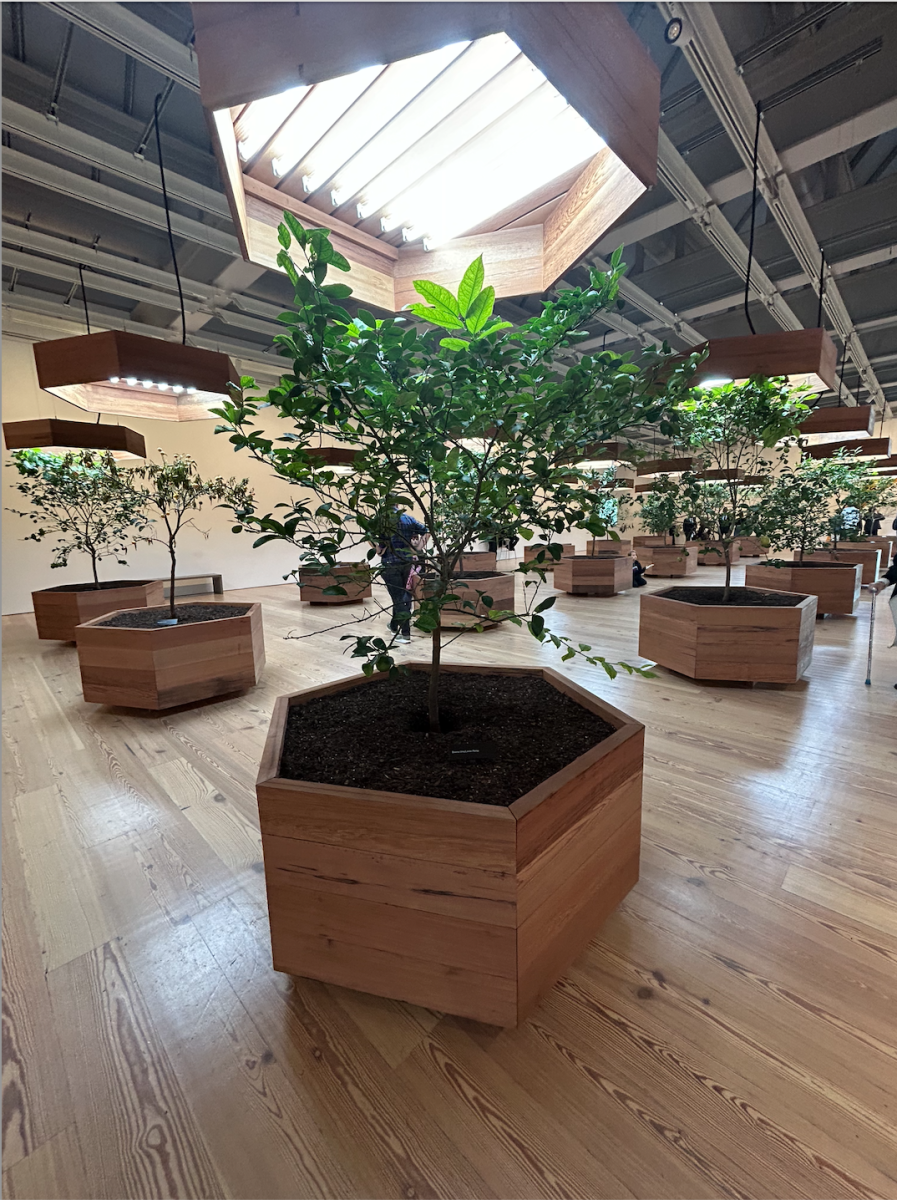Food sustainability.
It’s a term that’s recently become increasingly popular. In a world struggling with population growth, climate change, and natural resources, the conversation of sustainable food practices is more urgent than ever. Issues like the loss of agricultural land, heavy pesticide use, pollution, and the overconsumption of water resources pose serious threats to our food supply. While some practices, like lab-grown produce and crop rotation, have become more common, the growing pressures on agriculture, partnered with environmental and social concerns, raises a critical question: How far can we really go with food sustainability?
Many people have feared this question. It forces us to consider how we’ll feed ourselves in the coming decades, or even in a few years — which is where this exhibition comes in. ‘Survival Piece #5: Portable Orchard’ was created by ecological artists Helen and Newton Harrison in the early 1970s, and is currently on view at the Whitney Museum in Manhattan until January 5th, 2025.
The ‘Portable Orchard,’ a part of the Harrisons’ broader ‘Survival Pieces’ series, emerged during an important period of environmental awakening in the 1960s to 1970s. This era witnessed the rise of the environmental movement, as concerns about industrialization, resource depletion, and ecological damage intensified. The Harrisons’ work reflected a growing consciousness about humanity’s environmental impact, and their art engaged directly with issues of sustainability, human survival, and our relationship with nature.
By the early 1970s, environmental concerns had evolved into a global conversation about sustainability and human survival. The limits of Earth’s resources, the destruction of natural habitats, and the pressures of an ever-growing population were pushing the planet to its breaking point. In 1972, the influential ‘Limits to Growth’ report, published by the Club of Rome, issued a stark warning about the future of humanity. Based on extensive computer modeling, the report predicted that, if current growth patterns and consumption habits continued, the world would face catastrophic shortages in food, energy, and other resources.
These findings underscored the finite nature of Earth’s resources, highlighting the dangers of unchecked industrialization and overconsumption. The report resonated deeply with growing anxieties about ecological collapse and raised questions about whether the planet could sustain a rapidly expanding human population. This context of increasing alarm and urgency made the work of ecological artists Helen and Newton Harrison even more significant.
The Harrisons, pioneers in the field of ecological art, used their work to directly address these concerns. Both of them had backgrounds in art, with Newton specializing in painting and Helen in various other forms of creative expression, including sculpture. However, it was their shared interest in environmental issues that inspired them to shift the focus of their work from traditional artistic themes to broader concerns about the environment and sustainability. In the late 1960s and early 1970s, they became deeply involved in the emerging ecological movement, combining their artistic practice with scientific and ecological research. The Harrisons viewed art not just as a form of personal expression, but as a way to engage with pressing social and environmental issues.
Their series was born from these thoughts. The Harrisons sought to create art that could help address critical environmental problems, using the tools of art to engage with and comment on dire ecological issues of the time. The ‘Portable Orchard’ in particular was conceived during a period of heightened awareness about the limitations of industrial agriculture, and it responded to ecological devastation caused by conventional farming practices. The Harrisons were influenced by the growing realization that industrial agriculture was unsustainable.
The ‘Portable Orchard’ showcases the vulnerabilities of modern agriculture and raises questions about humanity’s ability to secure food for the future. The gallery is spread across the Whitney Museum’s 8th floor, and showcases 18 live citrus trees. These citrus trees are sustained indoors with individual lighting systems, representing a self-contained ecosystem. This exhibition stands as an exploration of what food production might look like in a world where ordinary farming methods cannot work anymore, which is what will happen if we do not change our ways.
Entering the exhibit, I was immediately surprised by the contrast between the natural beauty of the trees and the artificial systems designed to sustain them. The entire gallery floor is dedicated to these trees, each placed away from each other and illuminated by individual lighting systems, which is a technological attempt to replicate sunlight. The trees were identified by type, with signs posted onto each one.
However, what surprised me the most were the varying states of the trees. While most appeared healthy and fully grown, four looked as though they were in various states of wilting. It underscored a powerful point: even in a controlled, artificial environment, the process of growing food is not free of obstacles.
Not only did this illustrate how produce might be grown in a controlled environment, but it also highlighted the potential limitations of this method. Although traditional farming can also experience crop failures, this exhibit proved that even engineered ecosystems have their flaws, reminding us that no method of food production is foolproof. The inclusion of this fact, along with the various drawbacks of artificially grown produce, such as high energy consumption and nutrient limitations, made the exhibit a true reality check. While the controlled environment of ‘Portable Orchard’ initially seems like an innovative solution to future food scarcity, observing the wilting trees reminded me of the complexity and flaws behind artificial growing methods. It highlighted the fact that, despite the promise of technological advancements, creating sustainable and resilient food systems is far from straightforward. This exhibit does not just showcase a possible future for agriculture; it also underscore the potential pitfalls, raising questions about whether we can truly depend on artificial methods to meet our food needs.
‘Portable Orchard’ is a reflection on human survival and our relationship with food systems. The exhibit challenges visitors to imagine a future where humanity’s dependence on engineered ecosystems becomes essential. Each tree in this indoor grove symbolizes a fragile self-sustaining ecosystem, which hints at a potential future where we are forced to adapt to this new way of growing food.
As we consider the implications of the ‘Portable Orchard”’and the conversation of food sustainability, it becomes clear that the future of agriculture is in our hands. The Harrisons’ ‘Survival Pieces’ are a reminder of both the fragility and potential of our food systems. While their art highlights the vulnerabilities of artificial ecosystems, it also pushes us to rethink our relationship with the land, our food, and the environment. But, as daunting as it may seem, there are actions we can take today to create a more sustainable future.
So what can we do about it?
First and foremost, we can support and advocate for sustainable farming practices that prioritize soil health and biodiversity. Shifting away from industrial farming methods that rely heavily on pesticides and synthetic fertilizers is crucial for the long-term health of our ecosystems. Regenerative agriculture, which focuses on restoring the land rather than depleting it, offers one promising solution. By supporting local, organic farms and advocating for policies that provide sustainable practices, we can help shift the agricultural industry toward more eco-friendly methods.
In addition to reforming agricultural practices, we can reduce food waste, which is one of the biggest contributors to global food insecurity and environmental degradation. Simple actions like planning meals more efficiently, composting, and supporting businesses that prioritize reducing waste can have a significant impact.
Finally, it’s essential that we embrace innovation in food production, but not at the expense of the planet. Controlled-environment agriculture, such as hydroponics and vertical farming, can be part of the solution. However, these methods must be developed with sustainability in mind, focusing on energy efficiency and reducing waste.
In the end, the future of food sustainability is not set in stone. The decisions we make today, both as individuals and as a society, will determine the viability of our food systems tomorrow. Just as the Harrisons’ ‘Portable Orchard’ raises important questions, it also offers us an opportunity to take action, innovate, and reconsider how we produce and consume food.
By embracing a more sustainable approach to agriculture, food waste, and consumption, we can ensure that future generations will have access to the resources they need to thrive.
The future of our planet and our food depends on the choices we make now.
In the end, the future of food sustainability is not set in stone. The decisions we make today, both as individuals and as a society, will determine the viability of our food systems tomorrow.


